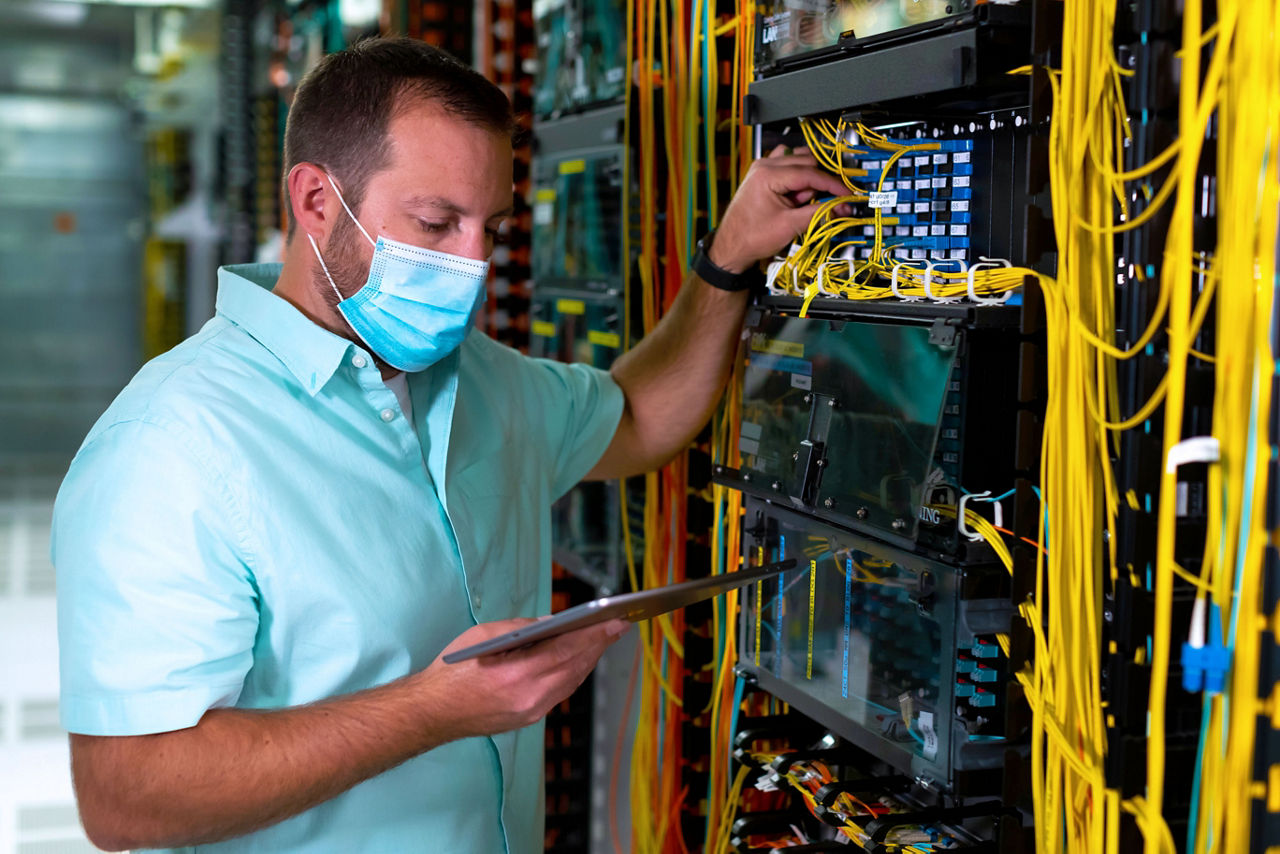- US - English
- China - 简体中文
- India - English
- Japan - 日本語
- Malaysia - English
- Singapore - English
- Taiwan – 繁體中文
Invalid input. Special characters are not supported.
Well, 2020 was not exactly something anyone could have predicted.
But with a brand-new year ahead and new insights from the year behind us, we asked our executives to weigh in on what technologies they predict could take off in 2021 and beyond, based on the trends we’re seeing today. Take a gander at what they anticipate in the ever-changing world of tech and how memory and storage will help power these changes. Just to name a few: artificial intelligence (AI) hitting Main Street, an acceleration of advanced driver-assistance systems, and 5G powering tele-everything. These shifts are fueling radical changes in memory and storage and exponential demand for high-bandwidth, energy-efficient solutions — from the cloud to the intelligent edge to consumer devices.
That said, no one truly has a crystal ball into the future, just as last year’s unpredictable nature goes to show. So without further ado, here are some predictions on what may be ahead, though only time will tell what changes we may see.
How the Pandemic Is Transforming the Data Center
Raj Hazra, Micron senior vice president of emerging products, corporate strategy & communications
The pandemic has quickened digital transformation. The fabric of our society in 2020 would have looked much different without cloud-derived digital services, including online shopping, virtual meetings and telehealth connections. The very research that delivered therapies and vaccines in record time was enabled by massive data crunching in the data center. These technologies became the foundation of our new normal; suddenly, things like AI self-learning models look far more approachable. Chief information officers’ risk tolerance has changed because they’ve had to deploy more nascent technology to keep their businesses afloat. These accelerated transformations will have rippling effects across enterprises in the year ahead.
In 2021, we expect the prevalence of remote work — even post-pandemic — will accelerate capabilities in the cloud. Companies will look to create preparedness for a new normal, whether that means more IT solutions for a flexible workforce, larger data stores to fuel continued growth of online commerce or resilient IT systems to address any future health care crises. This preparedness will drive unprecedented demand for agile IT infrastructure, multicloud solutions and pervasive connectivity to power edge-to-cloud use cases. While we see great opportunity for memory and storage to fuel increasingly data-centric cloud services, we will also see a rise in data center operators evaluating disaggregated, composable systems to better scale for coming enterprise demands.
- More pressure is being put on an energy-efficient cloud. The move toward composable infrastructure will be critical in reducing overprovisioned resources, and thus, mitigating the rising environmental impact of IT. Information and communication technology is already predicted to use 20% of the world’s electricity by 2030. As companies look to incorporate sustainability into business strategy and reduce operating expenses for compute-intensive workloads such as AI and high-performance computing, we’ll see escalating demand for energy-efficient architectures.
- Boundaries between memory and storage will blur. 2021 is going to see AI-as-a-service become mainstream, intelligence migrate to the edge, and 5G come to life. These advances are going to propel fundamental changes in the way server systems are architected. Memory will extend into multiple infrastructure pools — and become a shared resource. And the lines between storage and memory will blur. You’ll no longer think “DRAM for memory and NAND for storage.” Instead, faster NAND will create the ability to use it as memory, and applications will grow in their sophistication to use resourcing in innovative ways. In 2021, we’ll also see enterprises seeking new kinds of solutions, such as storage-class memory and memory virtualization, to further unlock the value of AI and exploding volumes of data.

AI Turns the Heat Up on Memory and Energy
Steve Pawlowski, Micron corporate vice president of advanced computing solutions & emerging memory solutions
- AI will become more accurate and more ubiquitous, and we'll start to see it filling in more gaps for simple tasks where people would traditionally say "Why would I ever use an AI algorithm for that?" For example, grocery stores might tap AI-enabled cameras that periodically check to see if shelves are empty and if so, alert clerks to restock. In a post-COVID world, we’ll see more businesses adopting AI for use cases like these to create contactless experiences. We’ll also see AI moving into infrastructure such as data centers and 5G base stations as neural network algorithms become more adept at workload and system error correction and recovery.
- You’ll have AI algorithms for simple, singular tasks and sophisticated algorithms for mapping the human brain. AI this agile requires a significant amount of memory bandwidth, and when you add memory bandwidth, you’re adding power. Researchers have found that training a single AI model can emit five times the lifetime carbon emissions of an American car (including manufacture).
These immense power requirements aren’t sustainable if AI is to be pervasive in our society, both in terms of the data center and our planet. In the next several years, we’ll see ecosystem players exploring new ways of powering AI in an energy-efficient manner. That exploration could mean taking AI architecture and moving it closer to the memory by stacking memory in a 3D package on top of the logic. Beyond the hardware, today there's a lot of bandwidth — and data — we're leaving on the table, meaning huge amounts of wasted energy. So in the years ahead, we’ll see a rise in technologists analyzing how to fine-tune AI algorithms to get as high performance as possible, but with extremely stingy power levels. Basically, it’s squeezing insights from every bit of data to ensure nothing goes to waste.
Autonomous Brakes, ADAS Accelerates
Kris Baxter, corporate vice president and general manager of Micron’s Embedded Business Unit
- 2021 will see broader adoption of the enriched in-cabin experience and advanced driver-assistance systems (ADAS), while a “tap on the brakes” toward fully autonomous vehicles is likely. The automotive industry continues on a transformational journey that has not been seen since the introduction of the automobile. That said, in this pandemic environment, we’ll see a slowing of the timeline toward fully autonomous vehicle deployments as automakers prioritize their investments and ridesharing companies pull back on fleet expansion — reducing the dollars, miles and data needed to advance the technology toward Level 4/5 autonomy in the near term. COVID put a damper on the aggressive adoption we might see otherwise in the autonomous space; at this point, people are hesitant about public transportation and ridesharing.
However, the fundamental growth drivers of the market remain intact, especially as consumers increasingly shop for vehicles more like smartphones, weighing up digital features like personalization and user experience (UX), rather than horsepower and make. We’ll see a rise in enriched features, including enhanced connectivity, larger digital displays and full digitalization of the cabin, with these serving as key purchase differentiators for consumers. The industry will exert a renewed focus on improving the effectiveness, safety and driver experience of Level2/2+ ADAS features (in some cases, due to governmental mandates) — driving growth in adaptive cruise control, automatic emergency braking, lane-keeping/changing, driver monitoring systems and C-V2X (cellular vehicle-to-everything) communications. In 2021, the market for these technologies is going to be very strong. These efforts together will help the industry make strides toward full autonomy in the long term.
When we reach that juncture, we believe that autonomous vehicles are going to make it into the enterprise first, such as robo-taxis via mobility-as-a-service providers as well as trucking and delivery solutions. These are areas that can afford the costs of full autonomy and reap enough return on investment for the economics to make sense.
"COVID put a damper on the aggressive adoption we might see otherwise in the autonomous space… people are hesitant about public transportation and ridesharing." Kris Baxter, Corporate vice president and general manager of Micron’s Embedded Business Unit
- The full benefit of autonomous factories is yet to be realized, but a trend toward microfactories will accelerate in 2021. The COVID-19 pandemic has strained manufacturing and the supply chain like never before. Most factories today are still based on the more than 100-year-old Henry Ford principle of massive scale and centralization. While the concept of distributed, agile, smaller, digital-first factories closer to end markets has been around for years, the pandemic and the need for some onshoring are catalysts that will speed this transition in certain areas in 2021. Microfactories will be built on the foundation of industrial internet of things (IIoT) and automation, enabling them to be nimbler and thus more responsive to demand closer to the source. This trend of intelligence at the edge will also propel demand for edge-to-cloud platforms to manage, connect and secure smart devices, factories and infrastructure. While many are early in the deployment of IIoT solutions, the full benefit of data analytics in smart factories has yet to be realized. The shift toward more automated manufacturing will accelerate the advancements and adoption of data technologies, enabling smart insights at the industrial edge.

The Future of Your Phone, 5G and Tele-Everything
Raj Talluri, senior vice president and general manager of Micron’s Mobile Business Unit
- 5G takes flight in a brave new socially distanced world. In 2021, we’ll see near-term benefits in mobile, especially with the deployment of 5G networks this year — which will accelerate globally. In fact, global 5G mobile phone shipments are expected to double in 2021 from 2020 to nearly 500 million units sold in 2021. The fast speeds and low latencies will enable people to truly multitask with their phones. Consumers will be able to stream a high-definition multiplayer video game to their television while video chatting, texting and doing work on their phones simultaneously. With all these rich, data-heavy mobile needs, in 2021, we’ll see increased demand for high-bandwidth, low-power memory, such as LPDDR5, which will be critical for keeping pace with compute-intensive behaviors without draining batteries. With order-of-magnitude-higher 5G download speeds (in turn, enabling users to download multiple 4K episodes of their favorite TV shows and movies quickly), we also expect increased storage requirements in smartphones.
Further ahead in the next few years, we’ll see 5G enable new and improved telemedicine, remote learning and virtual entertainment. Already, the pandemic has forced us to embrace these, but it’s clear that the optimal infrastructure isn’t there. As 5G becomes a reality and the cultural shift toward social distancing lingers, we could see it enabling 4K/8K high-resolution video for telemedicine, personalized AI-based teachers in virtual classrooms, and lag-free Zoom meetings. In 2021 and beyond, 5G might power inventive contactless experiences in retail, hospitality, interactive sporting, and entertainment experiences. Imagine immersive, 360‑degree, virtual experiences for arena sports such as football. These experiences will be enabled by multiple cameras shooting the same scene from different angles, with the smartphone processing together these feeds to create a real-time 360-degree view that allows users to choose the viewpoint they desire and watch the game from different angles in real time.
On the flip side, the promise that 5G will revolutionize our lives immediately or even by the end of this year is overhyped. It will take time for disruptive use cases to develop — maybe three to five years. First, the foundational 5G infrastructure and memory and storage need to be in place; then those disruptive applications will come.

Welcome to Your New Gaming Experience
Dinesh Bahal, corporate vice president and general manager of Micron’s Consumer & Components Group
- Your gaming experience will be completely transformed in the next few years. First, the console- and PC-based worlds are going to collide. This is the last generation of pure consoles; even today, with Xbox Game Pass and Netflix, the subscription extends beyond the PC or console — it connects everything! The console is going to get subsumed by a play-anywhere subscription. You’ll still need the compute on a central device, but you'll be able to seamlessly take your gaming experience across devices and screens. Cross-compatibility will become ubiquitous.
While many had anticipated that virtual reality (VR) would be ubiquitous in 2020, we’ll still be waiting for a VR breakout at the end of 2021. Why? VR continues to be hampered by its need for a high-end desktop (~$2,000), limiting VR users. But in the next few years, we expect VR to take hold with broad proliferation of 5G networks and embedded compute and memory within next-generation VR headsets. These advances will free VR experiences from their PC tethers, delivering high-resolution, full-immersion experiences to users.
Now look farther out: Imagine a PlayStation or Xbox transforming into a thin client with upgradable components, including memory and storage. Just plug in your wireless game pads and play. Remember, most of the world, including middle America, doesn't have fast internet, so the television is a natural platform for delivery of gaming services. And cross-compatibility with a small, thin client is the natural progression.
- Double, double, double! Next year, we’ll see doubling of PCIe adoption as it goes from niche to mainstream due to the increasing popularity of cloud and multiplayer. Average capacities of SSDs will double, while traditional spinning-disk hard drives will be marginalized to near death as gamers look for better performance and speed enabled by SSDs. We'll also see a doubling of people moving to faster 3200MHz and 3600MHz RAM speeds.

The Rise of AI at the Edge and Object Stores
Prasad Alluri, Micron vice president of corporate strategy
- The increase in AI means that its increasingly important that edge computing is near 5G base stations. Soon, in every base station, every tower might have compute and storage nodes in it. And there are lots of startups focused on building edge data centers that look like transport containers that sit in metro areas to enable content — like your Hulu videos — to be closer to the consumption. We’ll see the adoption of these edge data centers in the next few years, as enterprises and consumers look to tap massive amounts of data for insight and faster services closer to the source.
- Memory and storage are being reimagined. In 2021, look for more use of object stores — for storing structured and unstructured data, files, blocks and objects all in one repository. AI’s large data sets need proximity to where processing is happening. So, rather than viewing it as a large cold storage, object stores are going to be able to do AI-type workloads, which means large sets of data can be accessed with high bandwidth and low latency. As a result of the rise of data-intensive AI workloads, we’ll see the need for high-performance NVMe storage also increase, since this high-performing object store resides on flash-based storage, as opposed to the traditional, cold storage. This need could lead to faster adoption of Gen4 NVMe SSDs to enable more powerful object store for AI.
The predictions made within this article are for informational and entertainment purposes only. Though these predictions are made by Micron experts, they do not constitute market guidance for the company or the markets of our customers.
